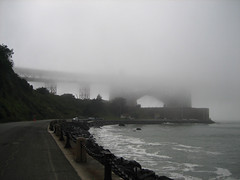Postmodernism is a notoriously tricky thing to define. Standing on Fort Point, poking out into the Golden Gate, looking for the place where Kim Novak jumped into the water in Vertigo, trying to commit suicide (Or was she?), only to have Jimmy Stewart fish her out, is a clear enough example.
Or the plaque in Burritt Alley:
ON APPROXIMATELY THIS SPOT
MILES ARCHER.
PARTNER OF SAM SPADE,
WAS DONE IN BY
BRIGID O’SHAUGHNESSY
Or the House on Montgomery Street, down the Filbert steps from Coit Tower, where Humphrey Bogart shacked up with Lauren Bacall in Dark Passages. One of the people who lives there now has a life-sized cardboard cutout of Bogie in the window. He’s smoking what seems to be a postmodern cigarette.
Up a flight of wood stairs from Bogey, we saw parrots, which are real parrots and not from a movie, except that they did star in a movie, a documentary about things that really happened. No way of telling if the parrots we saw were the same ones in the movie. They looked the same, though.
Or the real Chinatown Gates, on Grant, where Dullard and his posse go in search of Fred Mertz, the renegade meat cutter who opens a non-kosher butcher shop in the epic “Porklips Now”. That’s a real place, from a parody of a movie of a book. We’re three times removed here from the foundations of make-believe. That’s what the kids today call a mashup, sort of.
Lissa and I didn’t specifically intend a movie history tour of San Francisco – or a literary tour, for that matter. It just played out that way.
Riding the bus back to our hotel Monday evening after eating cheap fried fish on the waterfront, we jumped off when we realized we were near City Lights Books, the venerable temple to freedom of expression in North Beach. This is where Shigeyoshi Murao was arrested June 3, 1957, for selling a copy of Howl and Other Poems to a couple of undercover cops.
Lawrence Ferlinghetti, the shop’s owner, was charged too. The pictures of him from the time always seem to show a slightly bemused man in a nice jacket and a tie.
This was a real event, but its existence more in the retelling than the reality of the original means it shares certain similarities with Bogart and Bacall and Novak and Stewart. The trial was grand literary theater, with dumb villains and righteous art and crackerjack smart lawyers fighting for the light. The right honorable Judge Clayton W. Horn ruled four months later:
[T]he book Howl and Other Poems does have some redeeming social importance, and I find the book is not obscene.
In the years since, Howl has sold a million copies. I went upstairs to City Lights’ poetry room, a sort of holy temple, to procure my own copy. Howl was scary when I first read it 18 years after it was published (who ate fire in paint hotels or drank turpentine in Paradise alley, death). Do you need that to make art? That was the frightening part. I’ve got nothing in me that would “shiver the cities down to the last radio,” and no real desire to go get it.
I paid for the book on my American Express card, which seemed wrong, or perhaps just strange, but I am what I am now. I also bought a T-shirt.


Ahhhhh…
Best,
D (sometimes feeling stuck and not at home on the Front Range)
John,
On the plaque in Burritt Alley, does it really say SAME SPADE. Is he the same Spade as Sam Spade?
Oops. Yeah, same Spade as Sam Spade. 🙂
thanks for the shirt!